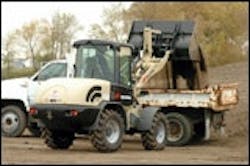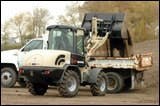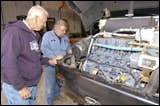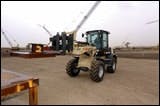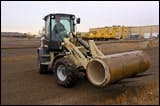Ingersoll Rand's WL-440 Compact Wheel Loader Keeps Up with a Pro
For this installment of Hands-On-Earthmoving, Ingersoll Rand graciously loaned us a brand new WL-440 wheel loader. The company's dealership in Villa Park, Ill., a Chicago suburb, delivered the machine to CE's test site, the Apprenticeship and Skill Improvement facility that Local 150 (International Union of Operating Engineers) maintains in Plainfield, just southwest of Chicago. Our evaluators were Local 150 operator/instructor Tom Rush and technician/instructor Rick Bewsey, who, after spending half a day with the WL-440, gave the loader generally high marks for design and performance, but did have a few suggestions for change.
The WL-440, weighing in around 13,200 pounds, is a compact model that was added to the Ingersoll Rand earthmoving line about 18 months ago, along with its slightly smaller companion model, the WL-350. The WL-440 we had on site produced 73 net horsepower from a transverse-mounted, four-cylinder, turbocharged Duetz BF 4M-2011 diesel engine. Early this year, however, the engine was changed to an 82-hp, turbocharged Kubota V3300-DI-T.
The loader uses a closed-circuit hydrostatic drive system (separate from the implement hydraulic system) that employs a variable-displacement hydraulic pump driven directly from the engine. The pump supplies oil flow to a single, two-speed hydraulic drive motor attached to a gear set at the front of the rear differential. Power reaches the front axle via a slip-tube shaft connected at the gear set with a universal joint.
An optional four-speed drive system uses two-speed axles in conjunction with the two-speed drive motor. This high-speed-travel ("speeder") system allows a top end of 22 mph, versus 12.4 mph for the standard system. The speeder option is advantageous, says Georg Seyrlehner, global product marketing manager, if the unit is frequently driven between work sites or is used on large developments to deliver materials or to make relatively long load-and-carry runs.
Both Local 150's Rush and Bewsey agreed that the WL-440 has quite a list of impressive features, including parallel-lift loader linkage that automatically keeps the bucket (or pallet forks) level throughout the lifting arc. The linkage is simpler in design than many parallel-lift systems, but, like most of these systems, maintains nearly constant power (breakout force) from the bottom to the top of the lift path.
Complementing the parallel-lift system is a standard hydraulic coupler that simplifies attachment changes. To swap work tools, from a bucket to forks, for example, the operator must first manually switch a small valve at the coupler from its auxiliary to its coupler position. Two buttons on the front of the joystick then power the coupler's locking pins. Once the valve is returned to its auxiliary position, the joystick buttons control the attachment's hydraulics, such as those for a multi-purpose bucket.
Attachments presently available include forks and numerous buckets, including multi-purpose and side-dump versions. According to Seyrlehner, the WL-440 can be equipped in the field with a fourth spool to provide continuous flow in the auxiliary-hydraulic system for powering attachments such as rotary brooms. (The standard third spool controls the coupler and bucket hydraulics.) Also, he says, the company is currently working to broaden its range of available attachments.
In operator Rush's opinion, the WL-440's cab is, overall, well designed. He liked our test machine's dual-entry doors, deeply curved one-piece windshield (giving a panoramic view forward), tilting and height-adjustable steering column and hydraulically cushioned seat. The cab is roomy and quite comfortable, says Rush, and it affords excellent visibility all around.
But, Rush, as do all operators, has his specific likes and dislikes about the details of machine design, and he admits that every operator has opinions about what makes for comfort and convenience in the cab. With that qualifier, Rush did confess that he was lukewarm about the WL-440's rocker switch at the top of the right joystick for making directional shifts.
"It's a small point," he says," but I find that if you're doing a multi-function operation with the joystick, it's difficult to shift without giving up a degree of hydraulic control. I would prefer a separate lever for directional shifts, along with a disconnect pedal."
A couple other cab details Rush noted included the close proximity of the control stalk (turn-signal/horn/lights) to the steering wheel. With gloves, he says, the operator may inadvertently trip the lever. He also questioned if the cab's skylight could be covered. He appreciates the overhead visibility afforded by the window at the forward edge of the cab roof, he says, but there might occasions when blocking the sun would make things more comfortable.
When performing basic dirt-work chores with the WL-440, Rush was generally impressed with the machine's performance. Exercises involved digging from a stockpile of moist, tightly compacted clay/loam soil, loading a single-axle truck and making a number of load-and-carry cycles.
"The machine has a lot of hydraulic power. I found that it hesitated just a bit in this heavy material when initially engaging the pile — during that instant when you're slightly raising the boom to load the front tires and beginning to curl the bucket. But, that said, the bucket comes up through the pile with a great deal of power."
As Rush maneuvered with a full bucket, he commented on what he considered the WL-440's excellent stability and precise steering. After a number of passes at the stockpile, he said he was impressed with the machine's apparent good design in splitting engine power between the hydraulic system and the wheels.
"There was plenty of power to push into the pile with no problem, but not so much that the tires would spin. We've found that a tire can lose 35 to 40 percent of its life when our apprentice operators spin the wheels."
When doing truck loading, Rush commented favorably on the WL-440's hydraulic speed and the machine's overall controllability.
"I could basically cycle as fast as I wanted. Hydraulic response is fast when approaching the truck and, again, the machine exhibits a good balance between tractive effort and hydraulic power. I also like how the hydrostatic system reacts when approaching the truck — lifting the throttle gives a natural, smooth braking effort."
Rush did comment that a return-to-dig control would be handy (it's an option), and also that the load-and-carry ride was a bit hard (ride-control is an option, too). The WL-440's bucket does, however, have "level" indicator bars on its sides.
A feature that Rush and Bewsey both questioned, however, was that of the WL-440's float-control system. A three-position switch on the right-hand panel has "off," "impulse" and "continuous" settings for float, which means that the loader mechanism is made hydraulically neutral and can follow (or float with) ground contour in such operations as back dragging.
In the impulse mode, the loader mechanism remains hydraulically active until a trigger switch on the front of the joystick is depressed. Pulling the trigger instantly places the boom in float, and it drops to the ground. Both Local 150 instructors agreed that the impulse mode would be a convenient feature in the hands of a seasoned operator. Because they work with novice operators, however, they raised the concern that rookies, perhaps experimenting with the controls, might place the float switch in the impulse position, then inadvertently engage the trigger when loading a truck and drop the boom.
Back on the positive side, though, Rush was again impressed with the WL-440's performance, this time with pallet forks. He used the forks to handle a heavy steel test fixture in the Local's equipment yard, and then transported a large section of concrete pipe.
"The machine was absolutely stable when equipped with forks; it lifted with plenty of power and kept the load level."
When asked to sum up the WL-440's overall performance, Rush did so succinctly:
"Everything considered, you have to remember that a machine this size probably isn't going to be used continually in heavy dirt work. But I think it would be an asset in any operation that needs a utility machine that can handle a variety of moderate tasks — maybe even some heavy-duty jobs."
